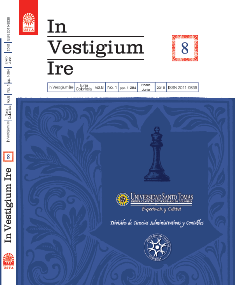ANÁLISIS DE LA POBREZA DESDE UN ENFOQUE MULTIDIMENSIONAL EN EL DEPARTAMENTO DE CÓRDOBA PARA EL AÑO 2012
Main Article Content
Abstract
This paper provides a measurement study of poverty in different dimensions in the department of Córdoba for 2012 using the Multidimensional Poverty Index (PMI) information from the Survey of Quality of Life. Population was characterized taking into account the dimensions and variables proposed by the PMI and then the different multidimensional poverty indicators were found. The results show that education, employment and housing conditions are the critical variables within the department in the period studied, identifying needs and opportunities for access to education, conditions which ensure the permanence of students in each grade, generation of quality employment in order to reduce informality and the improvement of housing conditions in the community.
Article Details
How to Cite
Ochoa-Reyes, L. M. (2016). ANÁLISIS DE LA POBREZA DESDE UN ENFOQUE MULTIDIMENSIONAL EN EL DEPARTAMENTO DE CÓRDOBA PARA EL AÑO 2012. In Vestigium Ire, 8(1), 92-111. Retrieved from http://revistas.ustatunja.edu.co/index.php/ivestigium/article/view/1004
Issue
Section
In Vestigium Ire Vol. 8
Investigium Ire of http://revistas.ustatunja.edu.co/index.php/ivestigium is licensed under a Creative Commons Attribution-NonComecial-NoDerivatives 4.0 International (CC BY-NCND 4.0)
References
Alkire, S., & Foster, J. (2009). Counting and Multi¬dimensional Poverty. En J. Von Braun, R. Hill, & R. Pandya-Lorch, The Poorest and Hungry: Assess¬ments, Analyses, and Actions (págs. 77-89). Inter¬national Food Policy Research Institute (IFPRI).
Alkire, S., & Seth, S. (2013). Multidimensional Poverty Reduction in India between 1999 and 2006: Where and How? OPHI WORKING PAPER NO. 60, 3-44.
Anand, S., & Sen, A. (1997). Concepts of human development and poverty: a multidimensional perspective. Human Development Papers, 1-19.
Angulo, R., Díaz, B., & Pardo, R. (2013). A Counting Multidimensional Poverty Index in Public Policy Context: the case of Colombia. OPHI WORKING PAPER NO. 62, 1-49.
Attanasio, O., & Székely, M. (Octubre de 1999). ci¬teseerx.ist.psu. Recuperado el 6 de marzo de 2014, de citeseerx.ist.psu: http://citeseerx.ist.psu.edu/ viewdoc/download?doi=10.1.1.201.3690&re¬p=rep1&type=pdf
Banco Mundial. (Octubre de 2004). worldbank. org. Recuperado el 12 de febrero de 2014, de worldbank.org: http://siteresources.worldbank. org/PRESIDENTSITE/Resources/jdw_bourguig¬non_spanish.pdf
Battiston, D., Cruces, G., López, L., Lugo, M., & San¬tos, M. (2009). Income and Beyond: Multidimen¬sional Poverty in six Latin American countries. OPHI WORKING PAPER No. 17, 1-29.
Boltvinik, J., & Damián, A. (2003). Derechos huma¬nos y medición oficial de la pobreza en México. Papeles de POBLACIÓN, 101-137.
DANE. (04 de septiembre de 2013). DANE. Recu¬perado el 25 de noviembre de 2013, de DANE: http://www.dane.gov.co/files/investigaciones/ condiciones_vida/pobreza/cp_pobreza_jun13.pdf
Larrañaga, O. (Octubre de 2007). eclac.cl. Recupe¬rado el 6 de Marzo de 2014, de eclac.cl: http:// www.eclac.cl/deype/publicaciones/xml/7/32087/ LCL2785e.pdf
Levine, S., Muwonge, J. & Batana, Y. (2012). Robust Multidimensional Poverty Profile for Uganda. OPHI WORKING PAPER No. 55, 1-35.
Núñez, J., & Ramírez, J. (2002). Determinantes de la pobreza en Colombia. Años recientes. CEPAL - SERIE Estudios y perspectivas, 1-53.
PNUD. (8 de Noviembre de 2000). fuac.edu.co. Recuperado el 25 de febrero de 2014, de fuac. edu.co: http://www.fuac.edu.co/download/ AREAS/10ipq.pdf
Robles, M. A. (Julio de 2008). eumed.net. Recu¬perado el 12 de febrero de 2014, de eumed.net: http://www.eumed.net/rev/cccss/02/mamr.htm
Sen, A. (1999). Desarrollo y libertad. Planeta.
Silva, A., González, P., & Peña, L. (2007). ¿Qué hogares colombianos son pobres? Una aproxi-mación desde la ECV del 2003. Revista Faultad
Ciencias Económicas Universidad Nueva Gra¬nada, 9-28.
Universidad ICESI. (s.f.). icesi.edu.co. Recuperado el 18 de febrero de 2014, de icesi.edu.co: http:// www.icesi.edu.co/cienfi/images/stories/pdf/glo¬sario/necesidades-basicas-insatisfechas.pdf
Valencia, G. D., & Cuervo, J. F. (1999). Crítica a las bases éticas de la teoría neoclásica en la propuesta del bienestar social de Amartya Sen. Lecturas de Economía, 113-148.
Verdera, F. (2007). La pobreza en el Perú: un análisis de sus causas y de las políticas para enfrentarla. Perú: CLACSO Libros.
Alkire, S., & Seth, S. (2013). Multidimensional Poverty Reduction in India between 1999 and 2006: Where and How? OPHI WORKING PAPER NO. 60, 3-44.
Anand, S., & Sen, A. (1997). Concepts of human development and poverty: a multidimensional perspective. Human Development Papers, 1-19.
Angulo, R., Díaz, B., & Pardo, R. (2013). A Counting Multidimensional Poverty Index in Public Policy Context: the case of Colombia. OPHI WORKING PAPER NO. 62, 1-49.
Attanasio, O., & Székely, M. (Octubre de 1999). ci¬teseerx.ist.psu. Recuperado el 6 de marzo de 2014, de citeseerx.ist.psu: http://citeseerx.ist.psu.edu/ viewdoc/download?doi=10.1.1.201.3690&re¬p=rep1&type=pdf
Banco Mundial. (Octubre de 2004). worldbank. org. Recuperado el 12 de febrero de 2014, de worldbank.org: http://siteresources.worldbank. org/PRESIDENTSITE/Resources/jdw_bourguig¬non_spanish.pdf
Battiston, D., Cruces, G., López, L., Lugo, M., & San¬tos, M. (2009). Income and Beyond: Multidimen¬sional Poverty in six Latin American countries. OPHI WORKING PAPER No. 17, 1-29.
Boltvinik, J., & Damián, A. (2003). Derechos huma¬nos y medición oficial de la pobreza en México. Papeles de POBLACIÓN, 101-137.
DANE. (04 de septiembre de 2013). DANE. Recu¬perado el 25 de noviembre de 2013, de DANE: http://www.dane.gov.co/files/investigaciones/ condiciones_vida/pobreza/cp_pobreza_jun13.pdf
Larrañaga, O. (Octubre de 2007). eclac.cl. Recupe¬rado el 6 de Marzo de 2014, de eclac.cl: http:// www.eclac.cl/deype/publicaciones/xml/7/32087/ LCL2785e.pdf
Levine, S., Muwonge, J. & Batana, Y. (2012). Robust Multidimensional Poverty Profile for Uganda. OPHI WORKING PAPER No. 55, 1-35.
Núñez, J., & Ramírez, J. (2002). Determinantes de la pobreza en Colombia. Años recientes. CEPAL - SERIE Estudios y perspectivas, 1-53.
PNUD. (8 de Noviembre de 2000). fuac.edu.co. Recuperado el 25 de febrero de 2014, de fuac. edu.co: http://www.fuac.edu.co/download/ AREAS/10ipq.pdf
Robles, M. A. (Julio de 2008). eumed.net. Recu¬perado el 12 de febrero de 2014, de eumed.net: http://www.eumed.net/rev/cccss/02/mamr.htm
Sen, A. (1999). Desarrollo y libertad. Planeta.
Silva, A., González, P., & Peña, L. (2007). ¿Qué hogares colombianos son pobres? Una aproxi-mación desde la ECV del 2003. Revista Faultad
Ciencias Económicas Universidad Nueva Gra¬nada, 9-28.
Universidad ICESI. (s.f.). icesi.edu.co. Recuperado el 18 de febrero de 2014, de icesi.edu.co: http:// www.icesi.edu.co/cienfi/images/stories/pdf/glo¬sario/necesidades-basicas-insatisfechas.pdf
Valencia, G. D., & Cuervo, J. F. (1999). Crítica a las bases éticas de la teoría neoclásica en la propuesta del bienestar social de Amartya Sen. Lecturas de Economía, 113-148.
Verdera, F. (2007). La pobreza en el Perú: un análisis de sus causas y de las políticas para enfrentarla. Perú: CLACSO Libros.


